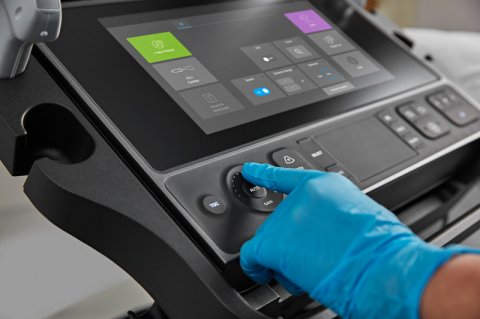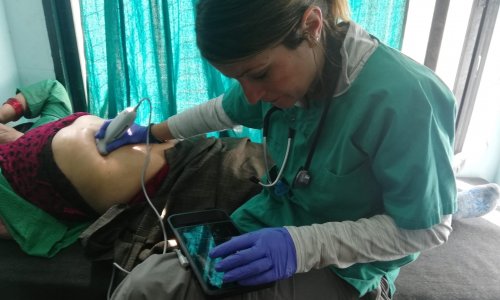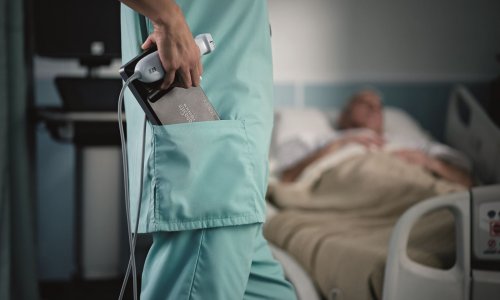
Image source: Fujifilm Sonosite
Sponsored • Ready to face the pandemic
Sonosite PX launches in a moment of crisis
This July, Fujifilm Sonosite launched Sonosite PX, its newest ultrasound system, in the midst of the Covid-19 pandemic. Diku Mandavia, M.D., Chief Medical Officer of Fujifilm Sonosite, sat down with sonographer and Sonosite’s Director of Marketing Development Jodi Miller to discuss how Sonosite’s newest ultrasound system can help frontline health care workers combat the pandemic and why Sonosite PX is uniquely suited for this global health crisis.
Jodi Miller: 'Some people may be asking, “Why launch Sonosite PX now, in the middle of a global pandemic?” Is there anything specific about Sonosite PX that can contribute to the care of the Covid-19 patient?'
Dr. Mandavia: 'Point-of-care ultrasound (POCUS) has risen in importance in this pandemic. In a very short time, POCUS has proven to be extremely valuable in the care of Covid-19 patients. We learned from experiences in China, Italy, UK, and New York City how extensive a disease Covid-19 is, with multi-organ system involvement. POCUS really contributes in the assessment and monitoring of these patients.
As I mentioned, Covid-19 is a systemic disease involving multiple organs. For these organs, we need superior clarity, such as cardiac imaging
Diku Mandavia
The two most important organs for Covid-19 assessment are the heart and lungs. And in those particular areas, we've made significant improvements in image quality. Sonosite PX has dedicated lung presets and a new lung exam type on the new C5-1 transducer. Sonosite also has our next-generation 2D cardiac and colour flow imaging. Having those abilities is going to be critical because those are the most-commonly performed applications. When you're doing your shock assessment, you're going to look at the heart, you're going to look at the lungs, and you’re going to look at the IVC. Sonosite PX is optimised for all of this.
As I mentioned, Covid-19 is a systemic disease involving multiple organs. For these organs, we need superior clarity, such as cardiac imaging. Sonosite PX has superior 2D and colour performance, which is going to be really important for hemodynamic assessments in Covid-19. Of course, the image improvements are across the board for all parts of the body. So whether you're talking about lung scanning, DVT scanning, or any other part of the body, Sonosite PX's image clarity will help the clinicians get to the answer quicker, faster.
Jodi Miller: 'Can you speak to how Sonosite PX can play a role in hospitals facing a surge?'
Dr. Mandavia: 'Most Covid-19 cases are seen in the ER and the ICU. And this is where Sonosite PX’s small footprint is extremely valuable. It is an optimal size, especially in the ICU, where you have a lot of equipment surrounding the bed. Sonosite PX's form, size, and shape are ideally suited for crowded spaces. You have a large enough screen so the care team can see what's happening with the patient, yet it has a small enough footprint that it can easily move in and out of ICUs. In fact, physicians who have previewed Sonosite PX have commented on that immediately. They saw that this device is going to be more accessible at the bedside. And the more accessible the system is, the more patients are going to get access to that imaging.'
Jodi Miller: 'Let’s talk a little bit more about the form factor and the adaptability of Sonosite PX.'
Dr. Mandavia: 'Sonosite PX is actually a hybrid system with the ability to adapt from a horizontal to a vertical position. This helps clinicians treat their patients by getting the system closer to the bed. As we know, these clinicians are either doing a diagnostic scan or an ultrasound-guided procedure. And depending on where the device is and what type of scan they're doing, the clinician may prefer the device in a standard configuration versus a vertical approach. So, you may prefer the standard or vertical approach depending on the procedure, whether it's vascular access or a nerve block. This flexibility is really important for the specific types of patients you’re treating.'
Jodi Miller: 'Given how contagious Covid-19 can be on surfaces, tell me about cleaning and disinfecting Sonosite PX.'

Image source: Fujifilm Sonosite
Dr. Mandavia: 'You don't want any device to inadvertently spread infection. When we were designing Sonosite PX, we listened closely to our customers about cleaning, disinfecting, and liquid ingress. So we designed Sonosite PX based on input from hundreds of physicians. And we got the message loud and clear that cleanability was at the top of the list, even before the Covid-19 pandemic appeared. Sonosite PX has a user interface that is a blend of touch and tactile, but also retains the quality of being more easily cleaned with all the buttons and surfaces being one piece. The surfaces are cleanable and have a sealed edge-to-edge surface preventing liquid ingress. This means that you can be confident that you can clean and disinfect both the system and transducers before you see the patient, and after you're done. The ease of cleaning helps save time. The transducer holder cups that were on previous systems are gone because those were harder to clean. That was a direct result of clinician input.
When Sonosite PX is used in a highly-contagious environment, such as a Covid-19 ward, it can be used with a clear, sterile drape. That makes cleaning much easier. Even with the drape over Sonosite PX, you can still see the images extremely well and control the entire system.'
Jodi Miller: 'How big of a role does advanced image clarity play in providing physicians confidence in their clinical diagnoses, particularly when caring for Covid-19 patients?'
Dr. Mandavia: 'Ultrasound imaging is a very user-dependent technology. So image acquisition and image interpretation are completely dependent upon the clinician that's using the device. And in point of care, specifically, many users tend to be less experienced. They may be in the learning phases and in those particular situations, actually having better image quality helps the more novice user. Having this higher resolution and clear definition of the anatomy is extremely important. And now, POCUS is scanning more regions and doing more sophisticated exams. So across the board, ultimately you're looking inside the body. The clearer, the anatomy is, the clearer the answer is. And it's all about having confidence of the answer in taking care of that patient.'
Jodi Miller: 'You mentioned Sonosite PX’s versatility with examining different parts of the body. Could you expand upon that?'
You will have a phased array, a curvilinear, and a linear which will, in essence, cover almost every application that you would need
Diku Mandavia
Dr. Mandavia: 'Sonosite PX is going to be your ultimate Swiss army knife for health care, a point-of-care ultrasound system that can image the entire body. And that's why it's particularly useful in managing Covid-19 patients. With Sonosite PX, you’re going to have available to you a whole new suite of transducers, from superficial imaging to deep imaging. You will have a phased array, a curvilinear, and a linear which will, in essence, cover almost every application that you would need. Having all that available at your fingertips is definitely ideal. We design, test, and manufacture our transducers, which allows us to continue to make them incredibly durable.'
Jodi Miller: 'How can Sonosite PX play a role in hospitals that are re-starting elective surgery?'
Dr. Mandavia: 'We know that in Covid-19, intubation is an extremely high-risk procedure for the anaesthesiologist, as well as the other surgical staff in the operating room. It’s a procedure with a risk of aerosols, so everyone is in danger of being exposed to Covid-19 viral particles. Both ASRA (American Society of Regional Anaesthesia) and ESRA (European Society of Regional Anaesthesia) recommend regional anaesthesia, if possible. Depending on the scenario, regional anaesthesia may be a very effective and very safe option, both for the patient and the surgical staff. And Sonosite PX is ideal for that as well.
These are areas where Sonosite PX’s image clarity is extremely important. When you're putting a needle all the way to the neurovascular bundle, where you have an artery and a nerve adjacent to each other, when you want to get the anaesthetic precisely adjacent to the nerve, but you don't want to get it inside the nerve, nor do you want to hit the artery. In those scenarios, Sonosite PX’s unparalleled clarity is really important.
And we also have to think about what happens after the surge, when hospitals return to elective surgery they will have a backlog, and will want do it safely. As I mentioned, intubation is risky, and increases risk of transmission of Covid-19. So if you can avoid it, that’s better. Regional anaesthesia is preferable, and Sonosite PX is perfectly suited for this procedure.'
Jodi Miller: 'Will Sonosite PX play a role in Covid-19 research?'
Dr. Mandavia: 'Absolutely. We’ve just launched a research collaboration with ACEP (American College of Emergency Physicians) and EMF (Emergency Medicine Foundation) to study point-of-care ultrasound in the care of Covid-19 patients. Based on the early reports over the last five months, we believe that even more ultrasound care pathways will be developed. EMF will choose three sites based on the quality of their projects. Then each site will get a Sonosite PX system and grant funding to conduct the study. We’re essentially deploying Sonosite PX to the front lines for both clinical care and Covid-19 research.
I look at ultrasound as a tool from the initial ER assessment all the way through to an ICU admission and recovery
Diku Mandavia
One of the things to understand about Covid-19 is that we learn—literally every week—more and more about this devastating disease. And we're learning how you can use ultrasound in the beginning to assess a lung injury, or assess as the patient progresses into cytokine storm, and for doing hemodynamic assessments. So ultrasound plays a crucial role in the continuum of Covid-19, where a patient initially presents with respiratory symptoms, but also if they develop complications such as shock, thromboembolism, and renal failure. I look at ultrasound as a tool from the initial ER assessment all the way through to an ICU admission and recovery.'
Jodi Miller: 'How does Sonosite PX facilitate ultrasound education, and how does this impact Covid-19?'
Dr. Mandavia: 'If you think about the front line care for Covid-19, many clinicians are still learning ultrasound. And much of the care is happening at large teaching hospitals. Furthermore, what we've seen in the pandemic is physicians in other specialties are being redeployed into the ER or the ICU. They may be, say, an internal medicine physician, or gastroenterologist, or an OB-GYN, and they may be deployed as a Covid-19 clinical physician.
Point-of-care ultrasound exams aren't extremely difficult, but they do require some education. Having access to educational resources is one of the most important elements of POCUS, certainly in the beginning. And this is where Sonosite PX really shines. We have more than 100 onboard 3D scan-along tutorials on how to do point-of-care ultrasound. So it's a device that helps you learn how to scan well.
Like all of our systems, every Sonosite PX comes with access to Sonosite Institute, which is one of the largest ultrasound online resource centres out there. We developed and aggregated educational content for point-of-care ultrasound applications in one area, and then made it accessible from a phone, laptop, or tablet. Within Sonosite Institute, there are learning pathways that enable clinicians to learn and complete different courses in all of the major applications within emergency medicine, critical care, anaesthesia, MSK specialties, and more.
Students can learn at their own pace. They take a pretest, watch the videos and webinars, and then they can take a post-test to pass the course. When they pass, they receive a certificate. This holistic solution is really important in point of care.
Sonosite Institute is a full learning management system, available in six languages. Within the medical imaging industry, there's no other source that is as comprehensive as Sonosite Institute. And we also provide the free SonoAccess app for iPhone and Android, which contains how-to videos, clinical images, reference guides, and other educational content.
We're the market leader in POCUS education. We’ve taught over 37,000 clinicians at workshops in the U.S. alone last year, and we have more than 600 training videos with 18 million views. Sonosite Institute has 27,000 active users, while our SonoAccess app has over 270,000 users around the world.
Many medical schools are now giving students exposure to ultrasound. These students will enter different specialties, which will further expand the use of POCUS. And it’s not just physicians. Nurses, paramedics, physician assistants, veterinarians, and athletic trainers are using POCUS. They will do more and more.'
Jodi Miller: 'Any final thoughts on Sonosite PX’s role in the pandemic?'
Dr. Mandavia: 'As we battle the Covid-19 pandemic, Sonosite PX is going to push the power of POCUS even further. First, Sonosite PX empowers the physician to take a whole body approach, as we learn how Covid-19 impacts different regions of the body. Second, Sonosite PX blends the best of both worlds of form factor and image clarity, so it’s ideally-suited for ICU and ER surges as well as post-surge for elective surgery. Third, we know physicians need more accurate answers, and quickly. To achieve that performance, we needed a new architecture. The 128-channel imaging allows increased clarity. Furthermore, every transducer for Sonosite PX is new. Our transducers aren’t only durable, they’re also made for superior imaging in the most demanding of environments. It’s easier to get the answers, all calculations are more easily accessible, and we have a phenomenal user interface with the right balance of tactile and touch.
To me, Sonosite PX is about solving problems. My journey into POCUS was to solve a problem in the early 1990s, when I found myself overwhelmed with trauma patients in at LAC+USC Medical Centre in Los Angeles. POCUS helped solve that problem by detecting internal bleeding at the bedside. Now every trauma centre in the U.S. is using POCUS.
Today, it’s a privilege to help the medical professionals fighting Covid-19. I know Sonosite PX can be part of the global effort to save lives from the ravages of this terrible pandemic. We’ve seen time and time again that ultrasound is a key component in managing Covid-19 patients. Sonosite PX is up for the job.'
01.01.2021











